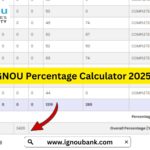BLI 223 Solved Assignment 2024-25 (Organising and Managing Information) of the BLIS Program. This assignment is valid up to 31st December 2025. This assignment is valid for those students who take admission or re-registration in the July 2024 and January 2025 admission cycles.
On the other side, those students who didn’t submit the assignment previously or were rejected by the ignou also do this assignment.
BLI 223 Solved Assignment 2024-25
Note: Answer all questions.
I) answer all the questions in not more than 500 words each.
1. Explain the rules in AACR-2R cataloguing of non-book materials.
Ans:
Ans: AACR-2R (Anglo-American Cataloguing Rules, 2nd Revised Edition) provides guidelines for cataloging non-book materials, ensuring standardized and consistent bibliographic descriptions. Non-book materials encompass a wide range of formats such as audiovisual materials, electronic resources, maps, microforms, and three-dimensional objects. Here are the key rules in AACR-2R cataloging of non-book materials:
- Title and Statement of Responsibility:
- Rule 1: Start with the title proper, which is the chief source of information for the item. Include subtitles, parallel titles, and other title information as necessary.
- Rule 2: Include a statement of responsibility, indicating the creators, contributors, or responsible entities associated with the item. Use abbreviations like dir. for director, ed. for editor, comp. for compiler, etc.
- Edition, Publication, etc.:
- Rule 2.4: Include edition statements if applicable, specifying edition numbering or other descriptive terms like revised edition, special edition, etc.
- Rule 2.5: Provide publication information, including the place of publication, publisher’s name, and date of publication. For non-book materials, this may include details such as production company, distributor, release date, etc.
- Physical Description:
- Rule 3: Describe the physical characteristics of the item, including format, size, duration (for audiovisual materials), sound characteristics, color, and any accompanying materials like booklets, user guides, or supplementary materials.
- Rule 3.5: Specify the number and type of physical units, such as discs, tapes, reels, etc., for multi-part items.
- Series Statement:
- Rule 4: If the item belongs to a series, include a series statement indicating the series title, numbering within the series (if any), and the series editor, if known.
- Notes:
- Rule 5: Include notes to provide additional information that enhances the understanding or usage of the item. This may include notes on special features, content descriptions, language options, subtitles, etc.
- Subject Access:
- Rule 6: Assign subject headings or descriptors to facilitate access based on the content and topic of the item. Use standardized subject headings from controlled vocabularies like Library of Congress Subject Headings (LCSH) or other authorized sources.
- Added Entries:
- Rule 8: Include added entries for persons, corporate bodies, and titles related to the item. This helps users find related materials by the same creator, contributors, or related titles.
- Series Added Entries:
- Rule 25: If the item is part of a series, include series added entries for the series as a whole, providing access to other items in the series.
- Electronic Resources:
- Rule 9: For electronic resources, include specific information such as mode of access (e.g., online, CD-ROM), system requirements, access restrictions, and URLs or DOI (Digital Object Identifier) where applicable.
- Maps and Cartographic Materials:
- Rule 3.3: For maps and cartographic materials, provide specific details such as scale, projection, coordinates, coloration, symbols, and cartographic notes describing the content and features of the map.
- Microforms:
- Rule 3.7: For microforms, specify the type of microform (e.g., microfilm, microfiche), reduction ratio, dimensions, and any accompanying guides or indexes.
- Audiovisual Materials:
- Rule 5G: Include notes on sound characteristics (e.g., mono, stereo, Dolby digital), color or black-and-white format, running time, language options, subtitles, and accompanying materials like scripts or transcripts.
- Three-Dimensional Objects:
- Rule 3.10: For three-dimensional objects, describe physical characteristics such as dimensions, materials, colors, textures, and any accompanying documentation or explanatory materials.
- Dissertations and Theses:
- Rule 21.1: For dissertations and theses, include specific details such as academic institution, degree type, year of submission, and additional notes on content, subject, and relevance.
- Indexing:
- Rule 6.5: Consider indexing by keywords, descriptors, or controlled vocabulary terms to enhance discoverability and retrieval of non-book materials based on user search queries and interests.
By adhering to these rules and guidelines, catalogers can create accurate, standardized, and comprehensive bibliographic records for non-book materials, facilitating efficient access, retrieval, and usage by library patrons and researchers.
2. Describe the main structure and salient features of DDC 19th edition.
Ans: The Dewey Decimal Classification (DDC) system is a widely used library classification scheme that organizes knowledge into ten main classes, each further divided into subclasses, divisions, and sections. The 19th edition of the DDC, also known as DDC 19, reflects updates and enhancements to the classification system to better accommodate new areas of knowledge and changing information needs. Here are the main structure and salient features of DDC 19th edition:
Main Structure of DDC 19:
- Ten Main Classes:
- 000-099: Generalities, including encyclopedias, libraries, information sciences.
- 100-199: Philosophy and psychology.
- 200-299: Religion.
- 300-399: Social sciences.
- 400-499: Language.
- 500-599: Pure science.
- 600-699: Technology.
- 700-799: Arts and recreation.
- 800-899: Literature.
- 900-999: History and geography.
- Subdivision Levels:
- Each main class is subdivided into ten divisions, and each division is further divided into ten sections, resulting in a three-digit notation for specificity.
- For example, within the 300s (Social sciences), 320-329 covers political science, with 321 specifically for political systems.
- Decimal Notation:
- The decimal notation system allows for precise classification and hierarchical organization, with each level of subdivision represented by a decimal point.
Salient Features of DDC 19:
- Expansion and Updates:
- DDC 19 incorporates expansions and updates to reflect new areas of knowledge, emerging disciplines, and changes in information landscapes. It includes revisions and additions to accommodate topics like digital technologies, environmental studies, and global perspectives.
- Faceted Structure:
- DDC 19 incorporates a faceted structure, allowing for multiple access points to information. Faceted classification enables users to approach subjects from different angles, enhancing the system’s flexibility and usability.
- Electronic Resources:
- DDC 19 includes classifications for electronic resources, digital media, and online content, reflecting the growing importance of digital information in contemporary libraries and information systems.
- Multidisciplinary Approach:
- DDC 19 adopts a multidisciplinary approach, facilitating the classification of interdisciplinary subjects and topics that span multiple traditional disciplines. This approach accommodates the integration of diverse knowledge domains.
- WebDewey Online:
- DDC 19 is available through WebDewey Online, an online platform that provides access to the classification system, updates, and additional features. WebDewey enhances the usability and accessibility of DDC for librarians, catalogers, and information professionals.
- Indexing and Navigation:
- DDC 19 includes comprehensive indexing and navigation tools to facilitate the location of specific subjects, topics, and resources within the classification system. Indexes, tables, and cross-references aid in efficient information retrieval.
- Interdisciplinary Connections:
- DDC 19 emphasizes interdisciplinary connections and relationships between subjects, encouraging users to explore interconnected areas of knowledge and discover related resources.
- Standardized Classification:
- DDC 19 provides a standardized classification framework widely used in libraries and information organizations globally, ensuring consistency and compatibility in cataloging and resource organization.
- Continual Updates:
- The DDC system undergoes continual updates and revisions to remain relevant and responsive to evolving knowledge domains, technological advancements, and user needs.
Overall, DDC 19th edition maintains the core principles of the Dewey Decimal Classification while incorporating enhancements to address contemporary information challenges, promote interdisciplinary access, and support effective information organization and retrieval in modern library environments.
3. Discuss the types and importance of notation, along with qualities of good notation.
Ans: Notation plays a crucial role in various fields, including mathematics, music, classification systems, and scientific notations. It serves as a symbolic representation or code that conveys information, instructions, or data in a concise and structured manner. There are different types of notation, each with its importance and qualities that contribute to effective communication and understanding.
Types of Notation:
- Mathematical Notation:
- Mathematical notation uses symbols, numbers, and characters to represent mathematical concepts, operations, formulas, equations, and relationships. Examples include algebraic expressions, calculus notation, matrices, vectors, and mathematical symbols such as +, -, ×, ÷, =, ∫, √, π, etc.
- Musical Notation:
- Musical notation is used in music to represent musical notes, rhythms, pitches, dynamics, tempo, and other musical elements. It includes staff notation, tablature, chord charts, rhythm notation, and symbols such as notes (whole, half, quarter, etc.), rests, clefs, time signatures, sharps, flats, dynamics (piano, forte), etc.
- Scientific Notation:
- Scientific notation is a system used in scientific and technical fields to express numbers in a compact and standardized format, particularly for very large or very small numbers. It consists of a coefficient, base, and exponent, such as 6.022 × 10^23 (Avogadro’s number) or 3.00 × 10^-8 (speed of light in a vacuum).
- Classification Notation:
- Classification notation is used in library classification systems such as Dewey Decimal Classification (DDC) and Library of Congress Classification (LCC) to organize and classify knowledge into categories, classes, subclasses, and divisions. It uses numerical and alphanumeric codes to represent subjects, topics, and resources.
Importance of Notation:
- Clarity and Precision:
- Notation ensures clarity and precision in conveying information, instructions, and data, reducing ambiguity and misinterpretation.
- Efficiency:
- Well-designed notation systems enhance efficiency by representing complex concepts, structures, or data concisely, saving time and effort in communication and analysis.
- Standardization:
- Standardized notation systems promote consistency and interoperability across disciplines, industries, and organizations, facilitating communication and collaboration.
- Accessibility:
- Notation systems make information accessible to a wider audience by providing a structured and organized format for encoding and decoding data, making it comprehensible to users with varying levels of expertise.
- Expressiveness:
- Notation allows for expressive representation of ideas, creativity, and artistic expression, particularly in fields like music, art, and literature.
- Computational Efficiency:
- In mathematics and computer science, efficient notation systems streamline calculations, algorithms, and programming tasks, improving computational efficiency and problem-solving capabilities.
Qualities of Good Notation:
- Clarity:
- Good notation is clear and unambiguous, ensuring that the intended message or information is easily understood by the target audience.
- Conciseness:
- Effective notation is concise, avoiding unnecessary complexity or redundancy while conveying essential information accurately.
- Consistency:
- Consistency in notation is important to maintain uniformity and coherence across different contexts, applications, or instances.
- Flexibility:
- A good notation system is flexible and adaptable, allowing for variations, extensions, or modifications to accommodate diverse needs and requirements.
- Intuitiveness:
- Notation should be intuitive and user-friendly, enabling users to grasp and interpret information quickly and intuitively without extensive training or explanation.
- Scalability:
- Scalable notation systems can handle a wide range of data, complexity levels, and scenarios, scaling up or down as needed without loss of clarity or effectiveness.
- Standardization:
- Standardized notation enhances interoperability, comparability, and compatibility across different systems, disciplines, or platforms, promoting communication and collaboration.
- Accessibility:
- Good notation promotes accessibility by catering to diverse audiences, including users with varying levels of expertise, cultural backgrounds, or sensory abilities.
In summary, notation is a powerful tool for communication, representation, and expression across various domains. The types and qualities of notation determine its effectiveness in conveying information, facilitating understanding, promoting efficiency, and fostering collaboration and innovation.
4. What do you meant by Dictionary Catalogue? Discuss its metrics and demerits.
Ans: A Dictionary Catalogue is a type of library catalog that organizes bibliographic entries alphabetically by author names, titles, subjects, and other access points. It aims to provide users with comprehensive access to library materials, facilitating efficient retrieval and navigation of information. Let’s delve into the metrics and demerits of a Dictionary Catalogue:
Metrics of a Dictionary Catalogue:
- Alphabetical Arrangement:
- Entries in a Dictionary Catalogue are organized alphabetically, making it easy for users to locate specific items based on author names, titles, subjects, or keywords. This arrangement enhances accessibility and quick retrieval of information.
- Multiple Access Points:
- Users can access materials through various entry points, including author names, titles, subjects, and cross-references. This multiple access approach caters to diverse user preferences and search strategies, improving the chances of finding relevant resources.
- Comprehensive Indexing:
- A Dictionary Catalogue indexes a wide range of bibliographic details, such as authorship, publication information, subject headings, edition details, and related works. This comprehensive indexing provides rich metadata for each item, aiding users in evaluating and selecting materials.
- User-Friendly Interface:
- The alphabetical arrangement and standardized format of a Dictionary Catalogue contribute to a user-friendly interface. Users can navigate the catalogue easily, locate items of interest, and understand the bibliographic information presented.
- Cross-Referencing:
- Cross-references are included to guide users to related materials or alternate access points. For example, cross-references may link variant titles, pseudonyms, series titles, or related subjects, enhancing the discoverability of library resources.
- Standardization:
- A Dictionary Catalogue follows standardized cataloging rules and formats, such as AACR2 (Anglo-American Cataloging Rules) or RDA (Resource Description and Access), ensuring consistency and compatibility with library standards and practices.
Demerits of a Dictionary Catalogue:
- Limited Subject Access:
- While a Dictionary Catalogue provides alphabetical access, its subject indexing may be limited compared to a classified catalogue. Users relying solely on subject headings may encounter challenges in comprehensive subject searching.
- Inefficient Subject Grouping:
- The alphabetical arrangement may not facilitate efficient grouping of materials by subject or topic. Users interested in exploring related subjects or interdisciplinary topics may find it cumbersome to navigate through scattered entries.
- Limited Contextual Information:
- The catalogue entries, primarily focused on bibliographic details, may lack contextual information such as summaries, annotations, or reviews. Users seeking in-depth content evaluation or contextual understanding may need additional resources or tools.
- Maintenance Challenges:
- Keeping a Dictionary Catalogue up-to-date requires continuous maintenance and updates as new acquisitions, editions, or revisions occur. Catalogers must ensure accuracy, consistency, and relevance in catalog entries over time.
- Overdependence on Alphabetical Order:
- The reliance on alphabetical order as the primary organizing principle may limit alternative access approaches, such as chronological, hierarchical, or faceted browsing, which could enhance user exploration and discovery.
- Limited Non-Textual Resources:
- A Dictionary Catalogue may face challenges in adequately representing and organizing non-textual resources such as audiovisual materials, multimedia content, digital resources, and three-dimensional objects. Specialized cataloging techniques may be needed for these materials.
II) Answer the following questions in 250 words each.
1. Discuss the various sections of a main entry of AACR-2R with illustrations.
Ans: The main entry of a bibliographic record in AACR2 (Anglo-American Cataloging Rules, 2nd edition, revised) consists of several sections that provide essential information about a resource. Let’s discuss these sections with illustrations for clarity:
- Main Entry Heading:
- The main entry heading is the primary access point for the bibliographic record. It typically includes the author’s name or corporate body responsible for the creation of the resource.
- Illustration:
- Title and Statement of Responsibility:
- Following the main entry heading is the title of the resource. If there are multiple titles, they are listed in the order prescribed by AACR2.
- The statement of responsibility indicates the individuals or entities responsible for the content, such as authors, editors, or illustrators.
- Illustration:
- Edition:
- The edition statement indicates the edition of the resource, such as “2nd edition” or “revised edition.”
- Illustration:
- Material Specific Details:
- This section includes information specific to the type of material, such as format (e.g., book, audiovisual), physical description (e.g., number of pages, size), and accompanying materials (e.g., maps, illustrations).
- Illustration:
- Publication Information:
- Publication information includes details about the publication, such as the place of publication, publisher’s name, and date of publication.
- Illustration:
- Series Statement:
- If the resource is part of a series, the series statement provides information about the series title, numbering within the series, and the series editor or publisher.
- Illustration:
- Notes:
- Notes contain additional information that may be relevant to the resource but does not fit into other sections. This can include bibliographic history, edition statements, and special features.
- Illustration:
- Standard Numbers:
- Standard numbers such as ISBN (International Standard Book Number) or ISSN (International Standard Serial Number) are included to uniquely identify the resource.
- Illustration:
These sections collectively provide a comprehensive view of the bibliographic details of a resource, allowing users to identify, locate, and access the material efficiently.
2. Discuss the structure of PRECIS indexing system.
Ans: PRECIS (Preserved Context Index System) is a controlled vocabulary indexing system used in library and information science for subject indexing and information retrieval. It was developed by Derek Austin in the 1960s and is based on the principles of semantic indexing, focusing on the meaning and context of terms. The structure of PRECIS is designed to enhance precision, consistency, and relevance in indexing. Here’s a breakdown of the structure of the PRECIS indexing system:
- Concept Analysis:
- PRECIS begins with a thorough analysis of the document’s content to identify key concepts, themes, and topics. This analysis involves understanding the context, scope, and depth of the document’s subject matter.
- Indexing Terms:
- Based on the concept analysis, PRECIS generates indexing terms or descriptors that represent the main ideas, subjects, and aspects covered in the document. These terms are selected to capture the essence of the content accurately.
- Category Selection:
- PRECIS categorizes indexing terms into specific categories or facets, reflecting different dimensions or aspects of the subject. Common categories include concepts, processes, objects, agents, attributes, and actions.
- Qualifiers:
- Qualifiers are used in PRECIS to further refine and specify indexing terms within categories. They provide additional context, specificity, and nuance to the terms, ensuring precise and granular indexing.
- Syntax Rules:
- PRECIS employs syntax rules to structure index entries in a standardized format. This format includes elements such as main terms, qualifiers, category indicators, and punctuation to create consistent and uniform index entries.
- Context Preservation:
- A key feature of PRECIS is its emphasis on preserving the context of terms within index entries. This context preservation ensures that the relationships between terms, their meanings, and their relevance to the document’s content are maintained.
- Postcoordination:
- PRECIS allows for postcoordination, which involves combining multiple indexing terms or qualifiers to create complex index entries that capture nuanced relationships or concepts. Postcoordination enhances the flexibility and expressiveness of indexing.
- Thesaurus Structure:
- The PRECIS indexing system is often organized as a hierarchical thesaurus structure, where terms are arranged in broader, narrower, and related terms, facilitating navigation and exploration of the index vocabulary.
Overall, the structure of PRECIS emphasizes semantic precision, context sensitivity, and systematic organization in subject indexing, enhancing the accuracy and effectiveness of information retrieval in library and information environments.
3. Define Canon of Recall Value.
Ans: The Canon of Recall Value refers to a set of principles or criteria used in information retrieval systems to evaluate the effectiveness and efficiency of the system in recalling relevant information in response to user queries. It focuses on the ability of the system to retrieve pertinent information from a collection of documents or resources based on user input. Here’s a detailed explanation of the Canon of Recall Value:
- Precision and Recall:
- In information retrieval, precision and recall are two important metrics used to assess the performance of a retrieval system. Precision refers to the proportion of retrieved documents that are relevant to the query, while recall refers to the proportion of relevant documents retrieved out of the total relevant documents in the collection.
- Canon of Recall Value:
- The Canon of Recall Value emphasizes the importance of recall in information retrieval. It states that a retrieval system should strive to achieve high recall rates, ensuring that a significant number of relevant documents are retrieved in response to user queries.
- Relevance and Coverage:
- The Canon of Recall Value underscores the significance of relevance and coverage in retrieval systems. Relevance refers to the degree of correspondence between retrieved documents and user information needs, while coverage pertains to the comprehensiveness of the retrieved documents in representing the full scope of relevant content.
- Evaluation Criteria:
- The Canon of Recall Value outlines evaluation criteria to measure the recall effectiveness of a retrieval system. These criteria may include:
- Exhaustiveness of Retrieval: The system should retrieve a substantial portion of relevant documents without missing significant content.
- Minimization of False Negatives: False negatives occur when relevant documents are not retrieved. The system should minimize false negatives to enhance recall.
- Sensitivity to Query Variations: The system should be sensitive to variations in user queries, ensuring that relevant documents are retrieved regardless of slight differences in query formulation.
- Incorporation of Relevance Feedback: Relevance feedback mechanisms, where users provide feedback on retrieved results, can improve recall by refining subsequent searches based on user preferences and relevance judgments.
- The Canon of Recall Value outlines evaluation criteria to measure the recall effectiveness of a retrieval system. These criteria may include:
- Optimization Strategies:
- To enhance recall value, retrieval systems may employ optimization strategies such as:
- Query Expansion: Adding synonyms, related terms, or broader concepts to queries to capture a wider range of relevant documents.
- Use of Controlled Vocabulary: Employing controlled vocabularies or subject headings to standardize and improve the precision and recall of indexing terms.
- Ranking Algorithms: Implementing ranking algorithms that prioritize highly relevant documents based on relevance scores or ranking criteria.
- Integration of Machine Learning: Leveraging machine learning techniques to analyze user behavior, preferences, and past interactions to personalize and optimize retrieval results for improved recall.
- To enhance recall value, retrieval systems may employ optimization strategies such as:
4. Discuss ALA Filing Rules for dictionary catalogue.
Ans: The ALA Filing Rules for dictionary catalogues, developed by the American Library Association (ALA), provide guidelines for arranging entries in alphabetical order in a catalog. These rules ensure consistency and standardization in filing practices, making it easier for users to locate materials in library catalogues. Here’s a discussion of the key aspects of ALA Filing Rules for dictionary catalogues:
- Author’s Last Name:
- When filing entries by author, editor, or creator, the ALA Filing Rules prioritize the last name first. This means that entries are arranged alphabetically based on the author’s surname, followed by their first name or initials.
- Title of the Work:
- If entries are filed by the title of the work, the ALA Filing Rules specify that articles such as “a,” “an,” and “the” are disregarded when determining alphabetical order. The main word in the title is used for filing purposes.
- Uniform Titles:
- For works with uniform titles, such as series titles or collective titles for multi-volume works, the ALA Filing Rules dictate the use of uniform titles for filing. This ensures consistent arrangement of entries for related works.
- Numerals and Symbols:
- Numerals and symbols are treated according to their alphabetical equivalent in the ALA Filing Rules. For example, numerals are filed as if they were spelled out (e.g., “10” is filed as “ten”).
- Subordinate Entries:
- Subordinate entries, such as editions, translations, or different versions of a work, are filed under the main entry. These entries are typically arranged chronologically or in a specified order based on the type of subordinate work.
- Corporate Names:
- Entries for works by corporate authors or organizations are filed under the first significant word of the corporate name. Articles and prepositions are generally ignored in this context.
- Cross-References:
- The ALA Filing Rules include provisions for cross-references to guide users to related entries or alternate access points. Cross-references are used when there are variant titles, pseudonyms, or other relevant information that may aid users in locating materials.
- Alphabetization of Names:
- The alphabetization of names in the ALA Filing Rules follows standard English alphabet rules, where letters are arranged in ascending order from A to Z. Accented letters or special characters may be treated according to their English equivalents.
Overall, the ALA Filing Rules for dictionary catalogues ensure systematic and consistent arrangement of entries, enhancing the usability and accessibility of library catalogues for users seeking to locate specific materials based on author names, titles, or other access points.
5. Illustrate the need and purpose ‘see’ entries in a thesaurus.
Ans: ‘See’ entries in a thesaurus serve a crucial purpose in enhancing information retrieval by guiding users to preferred or alternate terms, synonyms, or related concepts. These entries play a vital role in addressing the diverse ways users express their information needs and preferences. Here’s how ‘see’ entries fulfill the need and purpose in a thesaurus:
- Variety of Terminology: Thesauri encompass a wide range of terms, synonyms, and related concepts. Users may have varying preferences or familiarity with specific terms. ‘See’ entries acknowledge this diversity and provide alternative terms or synonyms that users may find more relevant or familiar.
- Enhancing Discoverability: ‘See’ entries enhance discoverability by directing users from a non-preferred term to a preferred or commonly used term. For example, a user searching for “automobile” may be directed to the preferred term “car” through a ‘see’ entry, ensuring they access the most relevant information.
- Clarifying Relationships: Thesauri often include hierarchical relationships between terms, such as broader terms (BT), narrower terms (NT), and related terms (RT). ‘See’ entries clarify these relationships by guiding users to broader or related concepts that may be of interest.
- Navigating Synonymy: Synonymy, where multiple terms refer to the same concept, can lead to ambiguity in information retrieval. ‘See’ entries help users navigate synonymy by suggesting synonymous terms or indicating preferred terms, reducing confusion and improving search precision.
- Suggesting Variants: Users may use variant spellings, abbreviations, or acronyms when searching for information. ‘See’ entries accommodate these variations by suggesting correct or preferred terms, ensuring users retrieve relevant results despite linguistic variations.
- Expanding Vocabulary: Thesauri aim to expand users’ vocabulary and conceptual understanding. ‘See’ entries encourage users to explore related terms, broader concepts, or specialized terminology, enriching their knowledge and facilitating interdisciplinary connections.
- Improving Search Efficiency: By providing ‘see’ entries, thesauri streamline the search process and improve search efficiency. Users spend less time navigating through multiple terms and synonyms, as ‘see’ entries guide them directly to relevant or preferred terms.
- Enhancing User Experience: Ultimately, ‘see’ entries contribute to a positive user experience by reducing search frustration, clarifying terminology, and ensuring users access the most pertinent information efficiently. They align with user-centric design principles, making thesauri more user-friendly and accessible.
6. Define Corporate Author. Discuss its types.
Ans: A Corporate Author refers to an organization, institution, or group that is credited as the creator or originator of a work, rather than an individual person. Corporate authors play a significant role in producing various types of documents, publications, reports, and materials across different fields. Here’s a definition of Corporate Author and a discussion of its types:
Definition of Corporate Author:
A Corporate Author is an entity, such as a company, government agency, nonprofit organization, association, research institute, or educational institution, that takes responsibility for producing or sponsoring a work. The name of the organization is used in place of an individual’s name as the author of the work.
Types of Corporate Authors:
- Government Agencies:
- Government agencies at the local, state, national, or international level often produce reports, publications, laws, regulations, and policy documents. Examples include the United States Environmental Protection Agency (EPA), World Health Organization (WHO), and National Aeronautics and Space Administration (NASA).
- Corporate Entities:
- Corporate entities, including businesses, companies, corporations, and firms, may produce annual reports, research studies, white papers, manuals, and marketing materials. Examples include Google, Apple Inc., Coca-Cola Company, and Microsoft Corporation.
- Nonprofit Organizations:
- Nonprofit organizations, charities, foundations, and NGOs (Non-Governmental Organizations) often publish reports, guides, research papers, and advocacy materials related to social, environmental, health, or humanitarian issues. Examples include Amnesty International, Red Cross, Greenpeace, and Oxfam.
- Educational Institutions:
- Educational institutions such as universities, colleges, schools, and libraries produce academic papers, textbooks, research publications, dissertations, and scholarly journals. Examples include Harvard University, Stanford University, Oxford University, and Library of Congress.
- Associations and Societies:
- Professional associations, societies, unions, and trade organizations publish industry reports, standards, guidelines, conference proceedings, and professional journals. Examples include American Medical Association (AMA), American Bar Association (ABA), IEEE (Institute of Electrical and Electronics Engineers), and American Psychological Association (APA).
- Research Institutes:
- Research institutes, think tanks, laboratories, and scientific organizations conduct studies, research projects, technical reports, and scientific publications. Examples include RAND Corporation, Brookings Institution, CERN (European Organization for Nuclear Research), and Max Planck Institute.
Each type of Corporate Author has its unique characteristics, purposes, and areas of expertise. Understanding the nature of the Corporate Author helps in identifying the context, credibility, and relevance of the work produced by these entities.
Conclusion
In this article, we provide BLI 223 Solved Assignment 2024-25 (Organising and Managing Information) of the BLIS Program. All the assignment questions are solved in this article. I hope you like this article and it will help prepare the assignment for your program.
If you have any questions related to this blog or any other of our blogs leave a comment below and we try to reply as soon as possible.
Happy Learning






2 thoughts on “BLI 223 Solved Assignment 2024-25: Free PDF Download”
BEVAE181: Environmental Studies
BHDLA135: हिंदी भाषा : विविध प्रयोग
BHIC131: HISTORY OF INDIA FROM THE EARLIEST TIMES UPTO 300 CE
BSOC131: INTRODUCTION TO SOCIOLOGY
BHDAE182: हिंदी भाषा और संप्रेषण
BHDLA136: HINDI BHASHA : LEKHAN KAUSHAL
BHIC132: HISTORY OF INDIA FROM C.300 TO 1206
BSOC132: SOCIOLOGY OF INDIA
Please send me assignments pdf